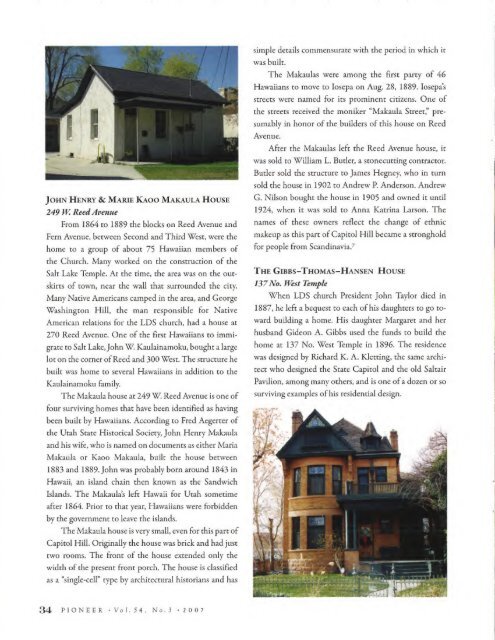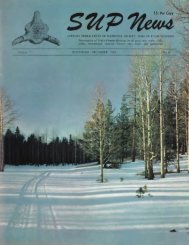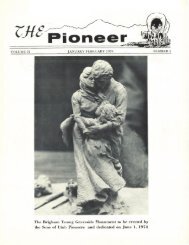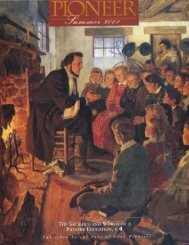Pioneer: 2007 Vol.54, No.3
The Pioneer Magazine is published by the National Society of Sons of Utah Pioneers
The Pioneer Magazine is published by the National Society of Sons of Utah Pioneers
Create successful ePaper yourself
Turn your PDF publications into a flip-book with our unique Google optimized e-Paper software.
simple details commensurate with the period in which it<br />
was built.<br />
The Makaulas were among the first party of 46<br />
Hawaiians to move to losepa on Aug. 28, 1889, Iosepas<br />
streets were named for its prominent citizens. One of<br />
the streets received the moniker “Makaula Street,” pre¬<br />
sumably in honor of the builders of this house on Reed<br />
Avenue,<br />
After the Makaulas left the Reed Avenue house, it<br />
was sold to William L, Butler, a stonecutting contractor,<br />
Butler sold the structure to James Hegney, who in turn<br />
sold the house in 1902 to Andrew R Anderson. Andrew<br />
John Henry 8c Marie Kaoo Makaula House<br />
249 W+ Reed Avenue<br />
From 1864 to 1889 the blocks on Reed Avenue and<br />
Fern Avenue, between Second and Third West, were the<br />
home to a group of about 75 Hawaiian members of<br />
the Church. Many worked on the construction of the<br />
Salt Lake Temple, At the time, the area was on the out¬<br />
skirts of town, near the wall that surrounded the city<br />
Many Native Americans camped in the area, and George<br />
Washington Hill, the man responsible for Native<br />
American relations for the LDS church, had a house at<br />
270 Reed Avenue. One of the first Hawaiians to immi¬<br />
grate to Salt Lake, John W, Kaulainamoku, bought a large<br />
lot on the comer of Reed and 300 West, The structure he<br />
built was home to several Hawaiians in addition to the<br />
Kaulainamoku family.<br />
The Makaula house at 249 W Reed Avenue is one of<br />
four surviving homes that have been identified as having<br />
been built by Hawaiians. According to Fred Aegerrer of<br />
the Utah State Historical Society, John Henry Makaula<br />
and his wife, who is named on documents as either Maria<br />
Makaula or Kaoo Makaula, built the house between<br />
1883 and 1889. John was probably born around 1843 in<br />
Hawaii, an island chain then known as the Sandwich<br />
Islands, The Makaulas left Hawaii for Utah sometime<br />
after 1864. Prior to that year, Hawaiians were forbidden<br />
by the government to leave the islands.<br />
The Makaula house is very small, even for this part of<br />
Capitol Hilk Originally the house was brick and had just<br />
two rooms. The front of the house extended only tire<br />
width of the present front porch. The house is classified<br />
as a “single-ceir type by architectural historians and has<br />
G. Nilson bought the house in 1905 and owned It until<br />
1924, when it was sold to Anna Katrina Larson. The<br />
names of these owners reflect the change of ethnic<br />
makeup as this part of Capitol Hill became a stronghold<br />
for people from Scandinavia.7<br />
The Gibbs-Thqmas-Hansen House<br />
137No. West Temple<br />
When LDS church President John Taylor died in<br />
1887, he left a bequest to each of his daughters to go to¬<br />
ward building a home. His daughter Margaret and her<br />
husband Gideon A, Gibbs used the funds to build the<br />
home at 137 No. West Temple in 1896. The residence<br />
was designed by Richard K. A. Kletting, the same archi¬<br />
tect who designed the State Capitol and the old Sakai r<br />
Pavilion, among many others, and is one of a dozen or so<br />
surviving examples of his residential design.<br />
34 PIONEER * Vo l. 5 4, No. 3 - <strong>2007</strong>







